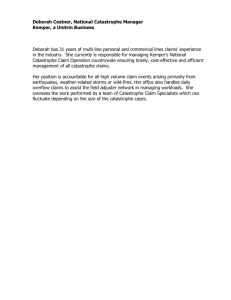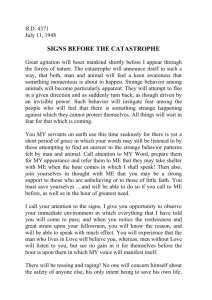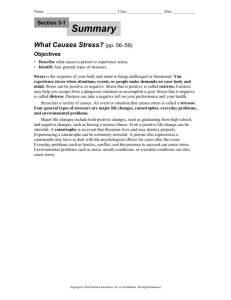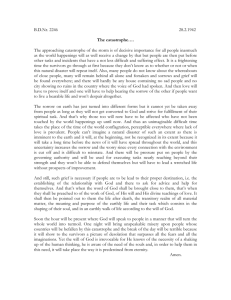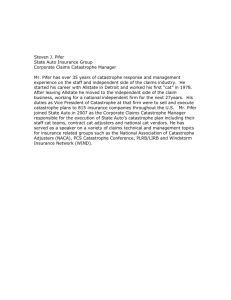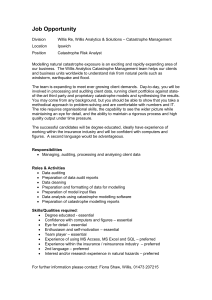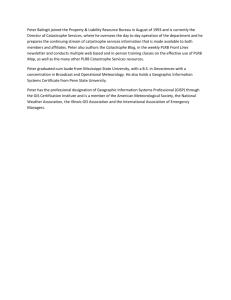The need for insurance against catastrophic risks
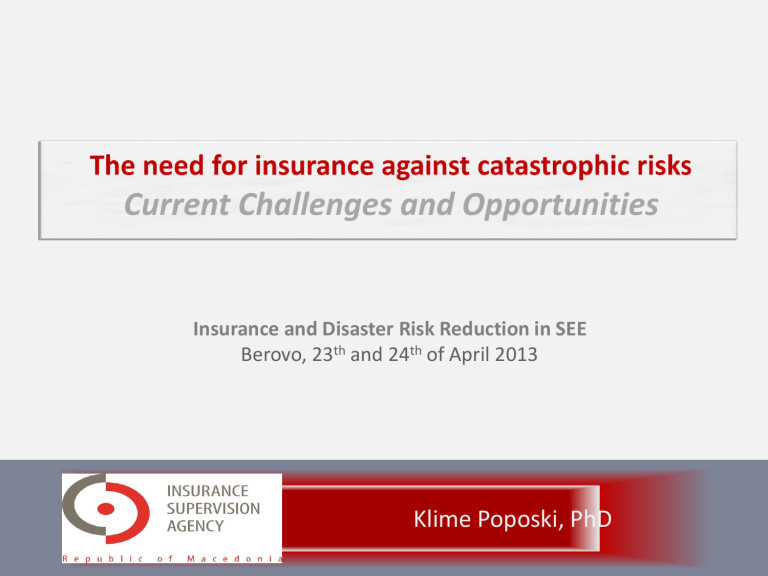
Insurance and Disaster Risk Reduction in SEE
Berovo, 23 th and 24 th of April 2013
Klime Poposki, PhD
Natural catastrophes and man-made disasters in 2012
Economic losses of over USD 186bn (2011: 403 bn – highest in history)
Claimed about 14.000 lives
The cost of insurers was approximately USD 77bn
(insured losses were the third highest on record since sigma began collecting natural catastrophes data in 1970)
Number of catastrophe events occurred 318
• 168 were natural catastrophe
• 150 were man-made disasters
Europe
• Economic losses about USD 27bn
• Victims 1.480
• The cost of insurers was over USD 5bn
• Emilia Romagna– an earthquake caused the loss of 26 lives and damages of
USD 16 bn
• UK– a heavy flooding caused losses of over USD 1.7 bn
• Eastern Europe- a low temperatures and heavy snow caused damages of
USD 0.3 bn and hundreds of lives
Source: Natural catastrophes and man-made disasters in 2012, No 2/2013, Sigma, Swiss Re
Natural catastrophes and man-made disasters in 2012
Insurance in disaster mitigation
1992 U.N. Framework Convention on Climate Change and the Kyoto Protocol refer to the potential role of insurance in disaster mitigation.
The Hyogo Framework for Action 2005–2015 identifies the need to promote the development of financial risksharing mechanisms, particularly insurance and reinsurance against disasters, as a priority action for building the resilience of nations and communities to recover from disasters.
Cost of the natural disasters
Catastrophe risk financing
More advanced economies:
typically funded through a combination of private risk financing arrangements and an efficient public revenue system relying on wide and deep taxation catchments.
Middle- and low-income countries:
relatively low tax ratios and ongoing fiscal pressures and where catastrophe risk markets are often underdeveloped;
funding sources for post-disaster reconstruction tend to be more varied, with strong reliance on ex post borrowing and assistance from international donors; and
lack of immediate liquidity in the aftermath of a disaster often retards recovery and forces the government to conduct an emergency budget reallocation, which can be harmful to the long-term fiscal stabilization programs and investment programs.
Multilateral financial agencies assistance
World Bank Financial and Private Sector Development assisted partner countries in the development of catastrophe risk financing solutions since the late 1990s:
Turkish Catastrophe Risk Insurance Pool
Mongolia Livestock Insurance Pool
Caribbean Catastrophe Risk Insurance Facility
Pacific Catastrophe Risk Pool Initiative
Romanian Catastrophe Pool
Case of Macedonia
Macedonia is highly vulnerable to natural disasters (especially earthquake and flood) and climate changes
Insurance coverage of natural hazards among homeowners and small and mid size businesses is almost non-existent
• only 1-2 houses out of 100 currently have catastrophe insurance coverage
In case of major damage event would have to appeal for government help
Catastrophe risk environment in Macedonia
Relatively small country with limited risk diversification possibilities and high risk accumulation in main cities
Low public awareness, culture, education
(state is considered as the only catastrophe risk absorbing mean)
Low level of insurance penetration and lack of standalone catastrophe products
Poor catastrophe insurance risk management, including lack of proper modeling
Lack of available / affordable risk transfer alternatives o Low business volumes to attract reinsurers or any other risk transfer means o Gap between local insurers and international reinsurers premium rates
Insurance Market in Macedonia
Insurance Market Profile
15 Insurance undertakings (11 non-life; 4 life)
22
9
Insurance brokerage companies
Insurance agencies
1 Bank which acts as insurance agency
660 Insurance agents
297 Licenses brokers
Insurance penetration - GWP in % of GDP – 1,44%
Insurance density - GWP per capita – 55,31 EUR/capita
Insurance Market in Macedonia
• Gross Written Premium :
2012: EUR 113.9 million (104.2 non life; 9.7 life)
2011: EUR 110.8 million (102.5 non life; 8.2 life)
2010: EUR 105.4 million ( 99.6 non life; 5.7 life)
2009: EUR 100.5 million ( 95.6 non life, 4.9 life)
↑ Gross Written Premium
↑ Non life premium
↑ Life premium
12/11
2.94%
1.56%
20.35%
11/10
5.05%
3.02%
40.19%
10/09
4.83%
4.16%
17.85%
Insurance Market in Macedonia
Market Concentration- 2012
Non – life companies
25,00%
20,00%
Triglav, 19.23%
(2011:19.38%)
15,00%
10,00%
5,00%
0,00%
Qbe, 10.66%
(2011: 11.79%)
Sava, 10.86%
(2011: 12.23%)
Evroins, 7.30%
(2011: 7.22%)
Eurolink, 12.35%
(2011:12.25%) Winner, 9.82%
(2011: 8.41%)
Insig, 2.84%
(2011:2.85%)
Ins. policy, 9.00%
(2011: 9.05%)
Uniqa, 7.70%
(2011: 7.38%) Albsig, 5.09%
(2011: 5.11%)
Croatia nonlife, 5.15%
(2011: 4.03%)
Life companies
50,00%
40,00%
30,00%
20,00%
10,00%
0,00%
Croatoa life, 40.76%
(2011: 40.44%)
Qbe life, 1.34%
(2011: 2.30%)
Grawe, 44.37%
(2011: 49.17%)
Winner life, 6.73%
(2011: 5.38%)
Uniqa life, 6.80%
(2011: 2.71%)
Case of Macedonia
GWP - Lines of business
4,88%
2,10%
7,30%
7,96%
2011
11,48%
47,96%
4,59%
2,03%
7,41%
8,53%
2012
10,87%
46,76%
18,31%
MTPL Motor insurance (casco) Accident Other non- life insurance
19,81%
Property insurance Travel insurance Life assurance
Insurance regulation in Macedonia
Main legal acts
• Law on Insurance Supervision – consolidated text (“Official Gazette of the
Republic of Macedonia” No. 30/2012);
• Law on compulsory insurance in traffic (“Official Gazette of the Republic of
Macedonia” No. 88/05, 70/06, 81/08, 47/11 and 135/11);
• 34 By-laws (secondary legislation acts) regulating issues with regard to licensing, accounting and financial reporting as well as risk management and supervision .
• 6 by- laws were adopted in 2012
Agriculture insurance
Earthquake
Flood
Hail and frost
Other property insurance
Earthquake
Flood
Hail and frost
Natural persons
Legal entities
Public institution
Case of Macedonia
Statistical data- 2012
Share in GWP- property insurance
2.58%
0.00%
0.00%
2.58%
13.03%
9.60%
2.12%
1.30%
Share in GWP- property insurance
2.23%
13.27%
0.10%
Share in total GWP
0.52%
0.00%
0.00%
0.52%
2.63%
1.94%
0.43%
0.26%
Share in total GWP
0.45%
2.68%
0.02%
Europa Re – reinsurance facility
What is Europa Re?
Non-profit catastrophe and weather risk reinsurance company for
Southeastern Europe and the Caucasus
Owned by countries (participants) of Southeastern Europe and the
Caucasus and supported by the World Bank and international donors
Europa Re is designed as a regional reinsurance pool that will benefit from economies of scale, regional risk diversification and state-of-the art risk management capabilities
Will cover geo-hazards: earthquake and weather related perils (flood, drought, freeze and hail)
Europa Re – reinsurance facility
Members:
Membership in Europa Re is open to all countries of Southeast Europe and the
Caucasus
Current Members:
• Macedonia, Albania and Serbia
Joining Europa Re:
• Accession negotiations for Montenegro and Bosnia and Herzegovina will take place during 2013
• Other countries from the region have also expressed interest in becoming Europa
Re shareholders in the near future
Europa Re – reinsurance facility
Expectations from Europa Re
To reduce the countries fiscal risk exposure to natural disasters through:
Expanded private insurance coverage of homeowners, SMEs and farmers
Coverage of government own assets
Insurance coverage of government own social obligations to socially vulnerable segments of population exposed to natural disasters
Locally licensed private insurance companies in participating countries will be able to issue standalone catastrophe insurance policies
Free technical assistance in designing new catastrophe insurance products (actuarial assistance and risk models)
To decrease the premium rates for weather risk and catastrophe insurance products in the member countries
To offer a reinsurance coverage for all insurance policies issued by insurers in accordance with the recommended risk underwriting and pricing guidelines of the
Facility and administered through their web-based underwriting platform
ISA as implementing agency
ISA is appointed by the Government of Republic of Macedonia as the project coordinator
Within the project were formed two working groups:
• Government working group
• Insurance working group
Two laws were adopted:
• Law on investments of the Republic of Macedonia in share capital of Europa
Re
• Law on borrowing by the Republic of Macedonia from the International bank for Reconstruction and Development- World Bank under the Loan agreement for financing the Project for insurance against natural disaster
ISA as implementing agency
Activities
Government working group
Government working group is created consisting of representatives of:
• ISA,
• Ministry of finance,
• Ministry of Economy,
• National bank of R. Macedonia,
• Ministry of Agriculture, Trade, Forestry and Water Management,
• Protection and Rescue Directorate & National coordinator for Reducing Risks,
• Institute of Earthquake Engineering and Seismology ,
• National Hydro meteorological Service, and
• National Bureau of Insurance .
o The main outcome of the working group deliberations is to formulate changes
(caused by the new risk-based catastrophe approach) in government pre-andpost policies that would shift the burden of disaster risk from government budget to the insurance sector
ISA as implementing agency
Activities
Insurance working group
Insurance working group is created consisting of representatives of the ISA , insurance industry and the National bureau and chaired by the ISA
The working group will be assisted by the Europa Re project consultants o The main outcome of the working group deliberations is the development of the risk-based supervision regulations, regulatory automated tools (risk models) and reporting standards for the markets
Introducing the risk-based supervision for catastrophe risks
Advantages compared to rule-based supervision:
Principle based
Better alignment with (internal) risk management developments
Economic perspective: all assets and liabilities are measured at fair value
Risk sensitive solvency requirements in line with recent market developments
Introducing the risk-based supervision for catastrophe risks
Strengthening the reporting standards o Additional template in the Rulebook for Insurance statistical standards, intended to present the main parameters related to main types of catastrophic risks
New rulebook on calculating the retention level and maximum probable loss o reinsurers and quality of reinsurance o reinsurance program o provisions related to catastrophic risks o reporting to ISA
Education and increasing the financial literacy o a wide PR campaign announced in 2013
Measures and challenges
Further steps….
Implementing risk-based supervision through the technical assistance of the
World Bank
Establishment of necessary regulation related to the tariffs and conditions
(including catastrophic risks)
Further increase of the awareness and culture for buying catastrophic coverage
Strengthening the international cooperation among Europa Re participants by signing MoU
Capacity building
Introducing the risk-based supervision for catastrophe risks
Objectives
Ensure adequate solvency of insurance companies writing property catastrophe business
The level of own surplus capital allocated to catastrophe insurance catastrophe reinsurance adjusted coverage aggregate gross PML for specified year return period
Introducing the risk-based supervision for catastrophe risks
Objectives
Ensure well designed and actuarially priced products
Ensure proper claim management practices
Establish a regulatory framework which sets minimum playground principles for all operators in the market
Lay the groundwork for the introduction of Solvency II
Challenges
Risk-based supervision approach is essential to ensure sound market development
Necessity of Public private partnership for overcoming the market failures
Mandatory or Voluntary
Thank You!
INSURANCE SUPERVISION AGENCY
Vasil Glavinov No.12, TCC Plaza, 2nd floor
1000 Skopje, Macedonia
Tel: +389 2 3254 050 Fax: +389 2 3290 240
E-mail: contact@aso.mk
www.aso.mk

